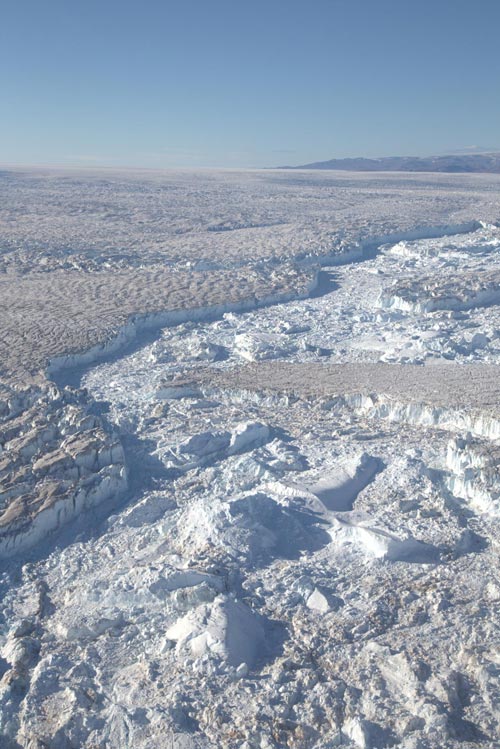Ice stream draining Greenland Ice Sheet sensitive to changes over past 45,000 years

This is ice calving of the Zachariae Isstrøm in Northeast Greenland. The icebergs can be up to 1 km in diameter and the ice front up to 100 m high. Credit: Nicolaj Krog Larsen
Interestingly, the loss of ice from the Northeast Greenland Ice Stream (NEGIS) took place not only during the warm Holocene period, but also during a period thought to be very cold preceding the last glacial maximum, the researchers say.
The findings suggest that NEGIS is particularly sensitive to environmental changes, which may exacerbate the influence of anthropogenic climate change. Results of the study are being published today in Nature Communications.
“There are some parts of the ice sheet that are relatively stable and others that show evidence of very rapid retreating – a pattern we're seeing today as well as thousands of years ago,” said Anders Carlson, an Oregon State University geologist and co-author on the study. “Some of it relates to bed topography – when the bed is below sea level, it stabilizes that part of the ice sheet. In low spots, it is unstable.”
Carlson said different factors may help explain the ice mass loss, including orbital forcing and warm summer temperatures. The path of the Earth's orbit put it closer to the sun some 9,000 years ago, breaking the planet out of its glacial maximum. NEGIS showed significant ice loss.
Yet it also showed a loss of ice during the period preceding that maximum, about 41,000 to 26,000 years ago, which is thought to have been very cold. OSU paleoclimatologist Christo Buizert, also a co-author on the study, reconstructed air temperatures from that period using ice core analysis and found that air temperatures indeed were much colder than average, but summer temperatures were warmer, which may have contributed to the ice loss.
“That period was also quite dry and there wasn't nearly as much snowfall,” Carlson said, “which may have driven the ice margin to be smaller.”
The researchers were able to determine where the ice sheet margins were essentially by analyzing the rocks for “sunburn,” Carlson said. When ice has retreated, the rocks become exposed to cosmic rays that hit the quartz in the rock and split the elements, creating beryllium-10. This cosmic bombardment leaves an elemental fingerprint that allows the researchers to reconstruct ice-free times over thousands of years.
“The anthropogenic forcing we are seeing today is having a significant impact on the ice sheet and it already has retreated to levels that weren't predicted to occur until the end of the century,” Carlson said.
A team of Danish and American researchers conducted much of the fieldwork, studying three fast-flowing marine-terminating “outlet” glaciers on the Greenland Ice Sheet.
“Modern observations have shown that the NEGIS is very susceptible to changes in both air and ocean temperatures and is presently in a phase of rapid ice retreat,” said Nicolaj Larsen of Aarhus University in Denmark, lead author on the study. Larsen spent much of the past year on sabbatical at Oregon State, where he collaborated with the OSU researchers.
###
Carlson and Buizert are with Oregon State University's College of Earth, Ocean, and Atmospheric Sciences. The study was supported by the Villum Foundation, Aarhus University's Arctic Research Center, and the U.S. National Science Foundation.
Media Contact
All latest news from the category: Earth Sciences
Earth Sciences (also referred to as Geosciences), which deals with basic issues surrounding our planet, plays a vital role in the area of energy and raw materials supply.
Earth Sciences comprises subjects such as geology, geography, geological informatics, paleontology, mineralogy, petrography, crystallography, geophysics, geodesy, glaciology, cartography, photogrammetry, meteorology and seismology, early-warning systems, earthquake research and polar research.
Newest articles

Innovative vortex beam technology
…unleashes ultra-secure, high-capacity data transmission. Scientists have developed a breakthrough optical technology that could dramatically enhance the capacity and security of data transmission (Fig. 1). By utilizing a new type…

Tiny dancers: Scientists synchronise bacterial motion
Researchers at TU Delft have discovered that E. coli bacteria can synchronise their movements, creating order in seemingly random biological systems. By trapping individual bacteria in micro-engineered circular cavities and…

Primary investigation on ram-rotor detonation engine
Detonation is a supersonic combustion wave, characterized by a shock wave driven by the energy release from closely coupled chemical reactions. It is a typical form of pressure gain combustion,…



